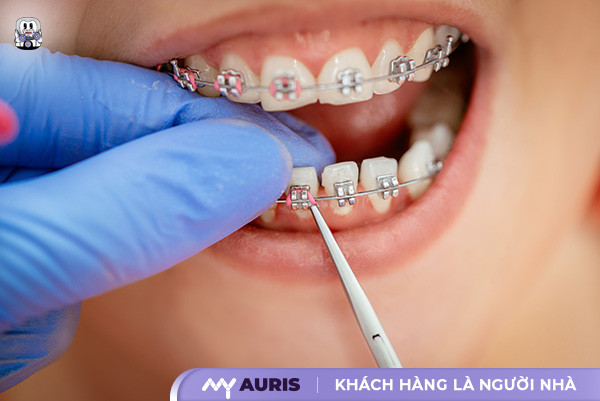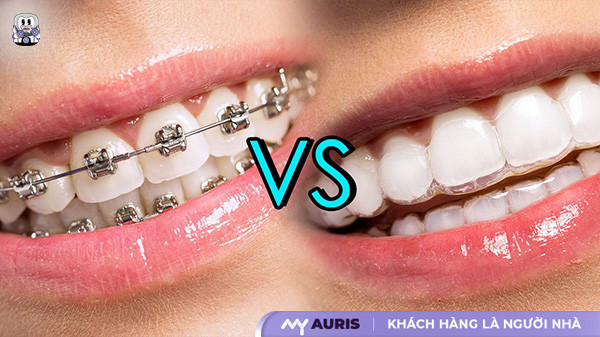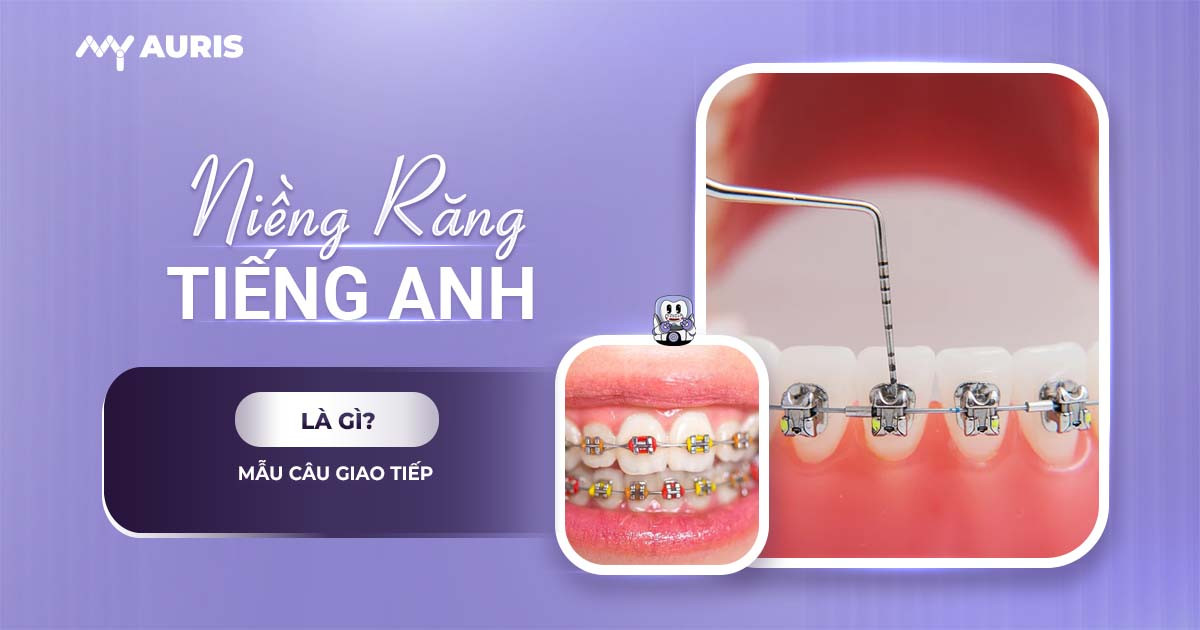What is braces in English? How are orthodontic appliances named in English? These are common questions customers have when learning about orthodontic treatment. As it involves specialized dental terminology, using the correct names will help you communicate easily with your dentist or access foreign materials more accurately. In this article, My Auris Dental will provide detailed, easy-to-understand, and reliable information from a professional perspective, helping you better understand the names used in the braces process according to standard English.
What is “Niềng răng” in English?
When looking up what “niềng răng” means in English, you will encounter two common terms: Orthodontics (/ɔ:θoudɔntiks/) and Braces (/breɪsɪz/). Both terms refer to straightening teeth, meaning orthodontics, and are used to describe methods of intervening with teeth and alveolar bone to move teeth to their desired position on the dental arch.
Orthodontics typically refers to the specialized scientific field that studies teeth straightening, a deep medical discipline.
Meanwhile, Braces are used to describe the orthodontic appliances, specifically the types of brackets attached to the teeth during treatment.
Usage examples:
I want to study orthodontics in the future. (Tôi muốn học chỉnh nha trong tương lai)
She has been wearing braces for two years. (Cô ấy đã đeo niềng răng được hai năm)

Common types of braces in English:
In English, to refer to specific orthodontic techniques, you can use the following phrases:
Cosmetic Braces – Niềng răng thẩm mỹ: This refers to optimal aesthetic orthodontic techniques such as ceramic braces, crystal braces, or clear aligners – methods that do not show brackets, providing confidence to the wearer.
Clear Braces – Niềng răng trong suốt: This method uses clear plastic aligners attached to the teeth instead of metal wires. It offers numerous aesthetic advantages, convenience, and safety, though at a relatively high cost.
Metal Braces – Niềng răng mắc cài kim loại: Traditional, highly effective, and reasonably priced.
Ceramic Braces – Niềng răng mắc cài sứ: These have a color similar to natural teeth, offering higher aesthetics than metal braces.
Lingual Braces – Niềng răng mặt trong: Brackets are attached to the inner surface of the teeth, helping to maintain aesthetics during communication.

Misaligned Teeth Conditions in English
Misaligned teeth is a familiar concept in dentistry, describing conditions where teeth are uneven, not properly spaced, or do not bite together correctly. These abnormalities not only affect aesthetics but also reduce chewing function and threaten long-term gum health.
This condition can stem from several factors:
- Genetics: Children are more likely to be affected if their parents have misaligned teeth.
- Wisdom teeth eruption: Erupting wisdom teeth (tooth number 8) can push the front teeth out of alignment.
- Bad habits from childhood such as thumb sucking, pacifier use, or frequent trumpet playing.
- Trauma: Accidents or impacts to the jaw area can also cause malocclusion.
During an orthodontic consultation with an international dentist, you’ll need to know some common terms for easier communication:
Gapped teeth or diastema (Răng thưa): Gaps between teeth, commonly seen in front teeth.
Example: “She has gapped teeth but she doesn’t mind.”
Overbite or overjet (Răng hô): The upper jaw protrudes significantly compared to the lower jaw.
Example: “He has a severe overbite that affects his speech.”
Underbite (Răng móm): The lower jaw protrudes excessively.
Example: “She has an underbite that makes her look angry.”
Crooked teeth (Răng khấp khểnh): Teeth that are misaligned, not straight in height or horizontally.
Example: “He has crooked teeth but he doesn’t want to wear braces.”
Crowded teeth (Răng chen chúc): Teeth do not have enough space to erupt in the correct position.
Example: “She has crowded teeth that make it hard to clean them.”
Malocclusion (Sai khớp cắn): Imbalance between the upper and lower jaws, or imbalance between teeth causing difficulty in chewing.
Example: “He has malocclusion that causes him pain and discomfort.”

Orthodontic Appliances in English
To help you better understand orthodontic appliances in English, the expert team at AI Smile – a leading entity in modern orthodontics – will guide you through the common orthodontic terms below. This is essential knowledge for anyone currently on or about to embark on their journey to improve their smile.
- Braces (Niềng răng): This is a traditional orthodontic method that uses brackets combined with an archwire to apply force, gradually moving teeth into the desired position.
- Clear aligners (Khay niềng trong suốt): This is a modern orthodontic method that uses clear plastic aligners to move teeth into the desired position. The aligners are removable, offering high aesthetics and convenience in daily life.
- Power chain (Thun buộc): This is an elastic chain attached to the brackets to close gaps between teeth, helping to create a beautiful, even smile and reduce tooth spacing issues.
- Elastics (Thun kéo): These are elastic bands attached to hooks on the upper and lower jaws, creating a pulling force between the two arches, playing an important role in precisely correcting the bite.
- Mini-screw (Vít niềng răng): This is a small screw inserted into the jawbone, serving as an anchor point to help move teeth, thereby increasing orthodontic effectiveness without affecting adjacent teeth.
- Retainers (Hàm duy trì): These are post-orthodontic appliances that help stabilize the teeth in their corrected position and prevent them from shifting back to their original state. This is a crucial step that cannot be overlooked to maintain long-term orthodontic results.
Common Phrases in Orthodontics
When undergoing orthodontic treatment, it’s essential to understand and be proficient in using simple phrases commonly used when booking appointments and visiting the dentist. This article will provide you with common orthodontic vocabulary along with phrases for scheduling appointments, helping you feel more confident when communicating with your dentist or clinic staff – especially in an English-speaking environment.
Appointment Booking Phrases for Clients – For Consulting Staff
- Would you like to make an appointment to see the dentist?
Would you like to make an appointment to see the dentist? - Please tell me your first and last name.
Please tell me your first and your last name - Can we schedule you for Monday?
Can you arrange some time on Monday? - Do you currently have any health issues?
How long have you had the symptoms? - Are you busy on Tuesday?
Are you free/available on Tuesday? - What year were you born?
When were you born? - Would you please provide me with some personal information?
Would you please give me some personal information? - What seems to be the problem with your teeth?
Have you had any problems?
Phrases for Clients When Meeting the Dentist
- What is “Tôi đang niềng răng” in English?
I’m wearing braces. - I have a very pronounced underbite.
I have a very pronounced underbite. - I have a toothache.
I have got toothache. - I have chipped a tooth.
I have chipped a tooth. - How much does my dental work cost?
How much does it cost? - What do I need to keep in mind for home dental care?
What do I need to do when I get home?
Dentist’s Phrases – Effective Communication
- Would you like to come through to the examination room?
Would you like to come through? - Please take a seat.
Please take a seat. - Can you open your mouth, please?
Can you open your mouth, please? - A little wider, please.
A little wider, please. - You’ve got a bit of decay in this tooth.
You’ve got a bit of decay in this one. - I’m going to have to extract this tooth.
I’m going to have to take this tooth out. - Let me know if you feel any pain.
Let me know if you feel pain.
Above are common phrases in orthodontics, including phrases for booking appointments, scheduling client meetings, and communication between dentists and patients. Whether you are a clinic staff member or someone looking up what “niềng răng” is called in English, this knowledge is useful and worth remembering.





